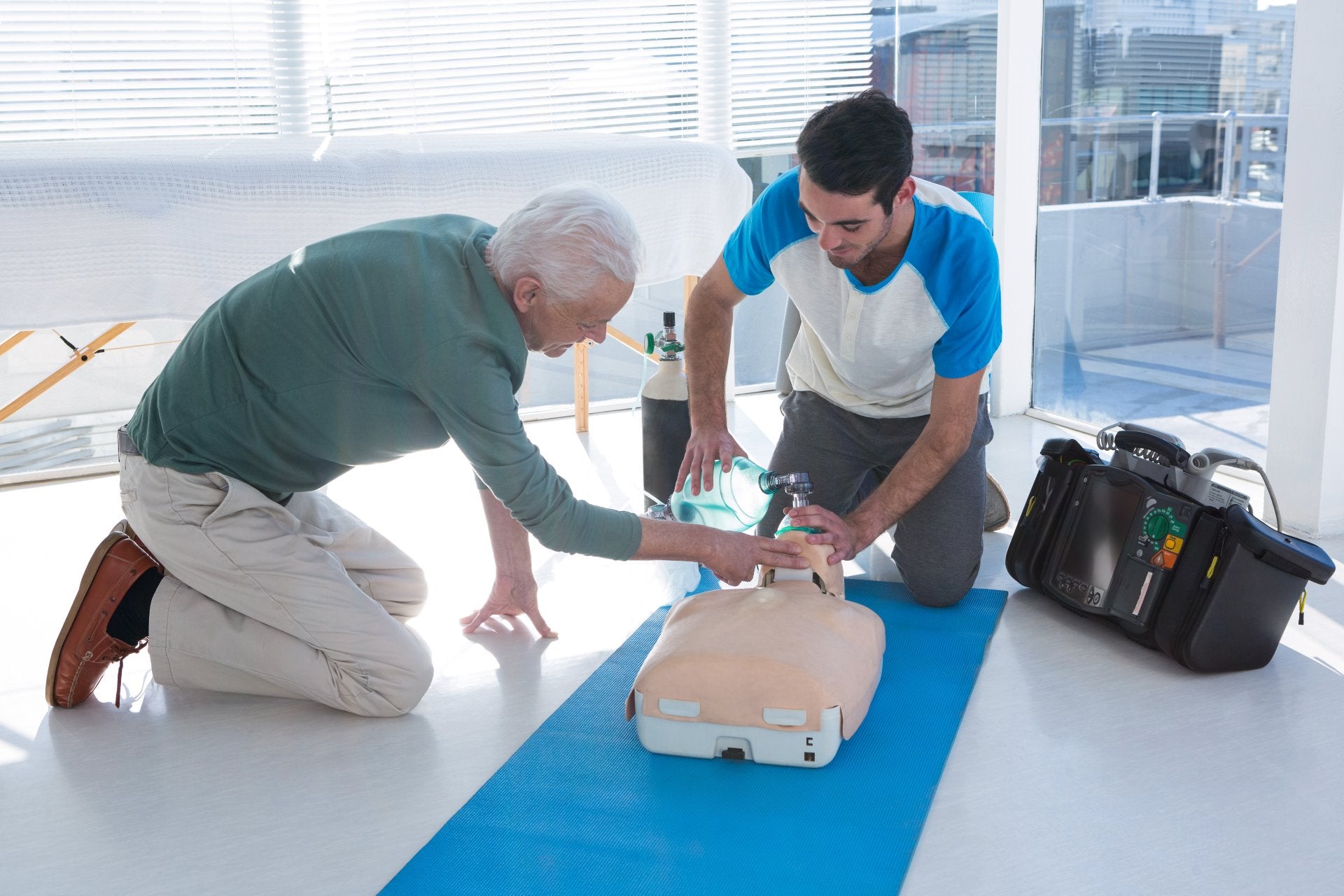Resuscitation training requirements for general practices
The essential guide to resuscitation training requirements for general practices in the UK
By Dr Richard Dune

Image by LightFieldStudios via Envato Elements
In the UK, general practices (GPs) are often the first point of contact for patients needing immediate care. Though cardiac arrest incidents in general practice settings may be infrequent, the ability of GP staff to respond swiftly and effectively can mean the difference between life and death. Resuscitation training, particularly in cardiopulmonary resuscitation (CPR) and the use of automated external defibrillators (AEDs), is essential to ensure readiness for these critical situations.
UK regulations, especially those enforced by the Care Quality Commission (CQC), require that all general practice staff - including clinical and non-clinical members - be adequately trained to respond to both adult and paediatric emergencies. In this blog, Dr Richard Dune explores the regulatory requirements, the importance of hands-on training, and best practices for implementing and maintaining effective resuscitation protocols in general practice settings.

Image by isitophotostock via Envato Elements
Understanding resuscitation and its importance in primary care
Resuscitation involves life-saving procedures, including CPR and AED use, aimed at restoring breathing and circulation in individuals experiencing cardiac or respiratory arrest. These skills are critical in primary care settings, where time-sensitive interventions are often required before emergency medical services can arrive. Immediate and proficient resuscitation efforts increase a patient's survival chances, particularly when initiated within the first few minutes following cardiac arrest.
The impact of early resuscitation on patient outcomes
Research indicates that swift action with CPR and AED intervention can double or triple survival rates. According to the NHS, ambulance services handle approximately 30,000 out-of-hospital cardiac arrests annually, highlighting the need for quick and effective response capabilities at the community level. For general practices, where resources and proximity to hospitals may vary, resuscitation training equips staff to stabilise patients during critical periods.

Image by GSR-PhotoStudio via Envato Elements

Image by DC_Studio via Envato Elements
Key resuscitation training requirements for GP staff in the UK
UK resuscitation training requirements for general practices are framed by several regulatory standards, which mandate regular, hands-on training to maintain readiness. Here’s a breakdown of the critical requirements for adult and paediatric resuscitation competencies:
Relevant regulatory standards and guidelines
In the UK, resuscitation requirements for GPs are regulated by various healthcare standards to ensure patient safety and quality of care. Here are the primary regulatory guidelines and how they apply to resuscitation in general practice:

Image by BLACKDAY via Envato Elements

Image by YuriArcursPeopleimages via Envato Elements
Implementing effective resuscitation policies and procedures in general practices
Given the regulatory landscape, implementing robust resuscitation policies and procedures is essential for GP practices to ensure compliance, safety, and staff readiness. Here’s a guide to implementing effective resuscitation protocols
Practical training and competency requirements
To ensure practical competence, resuscitation training for GP staff should include the following core components:
- CPR for adults and children - Correct chest compression techniques, rescue breathing, and positioning for different age groups.
- AED use - Training in AED operation, including electrode placement for adults and children, safety protocols, and shock delivery.
- Basic airway management - Ensuring open airways with appropriate manoeuvres, particularly for paediatric patients where airway considerations differ from adults.
These competencies should be assessed annually to confirm that staff can perform them effectively and confidently.

Image by Wavebreakmedia via Envato Elements

Image by DragonImages via Envato Elements
Conclusion - Building a culture of readiness in general practice
Effective resuscitation training in general practices is critical to patient safety and care quality. GP practices meet regulatory standards and foster a culture of readiness and confidence by equipping clinical and non-clinical staff with the skills to handle emergencies. This proactive training and equipment maintenance approach ultimately supports better outcomes for patients experiencing cardiac or respiratory arrest.
Stay compliant with high-quality resuscitation training
Empower your practice with compliant, high-quality resuscitation training. Ensure your team meets the latest CPR, AED, and BLS standards for adults and children. For more information on our tailored training programmes, visit The Mandatory Training Group to learn more.
Understanding resuscitation and its importance in primary care

Image by isitophotostock via Envato Elements
Resuscitation involves life-saving procedures, including CPR and AED use, aimed at restoring breathing and circulation in individuals experiencing cardiac or respiratory arrest. These skills are critical in primary care settings, where time-sensitive interventions are often required before emergency medical services can arrive. Immediate and proficient resuscitation efforts increase a patient's survival chances, particularly when initiated within the first few minutes following cardiac arrest.
The impact of early resuscitation on patient outcomes

Image by GSR-PhotoStudio via Envato Elements
Research indicates that swift action with CPR and AED intervention can double or triple survival rates. According to the NHS, ambulance services handle approximately 30,000 out-of-hospital cardiac arrests annually, highlighting the need for quick and effective response capabilities at the community level. For general practices, where resources and proximity to hospitals may vary, resuscitation training equips staff to stabilise patients during critical periods.
Key resuscitation training requirements for GP staff in the UK

Image by DC_Studio via Envato Elements
UK resuscitation training requirements for general practices are framed by several regulatory standards, which mandate regular, hands-on training to maintain readiness. Here’s a breakdown of the critical requirements for adult and paediatric resuscitation competencies:
Relevant regulatory standards and guidelines

Image by BLACKDAY via Envato Elements
In the UK, resuscitation requirements for GPs are regulated by various healthcare standards to ensure patient safety and quality of care. Here are the primary regulatory guidelines and how they apply to resuscitation in general practice:
Implementing effective resuscitation policies and procedures in general practices

Image by YuriArcursPeopleimages via Envato Elements
Given the regulatory landscape, implementing robust resuscitation policies and procedures is essential for GP practices to ensure compliance, safety, and staff readiness. Here’s a guide to implementing effective resuscitation protocols
Practical training and competency requirements

Image by Wavebreakmedia via Envato Elements
To ensure practical competence, resuscitation training for GP staff should include the following core components:
- CPR for adults and children - Correct chest compression techniques, rescue breathing, and positioning for different age groups.
- AED use - Training in AED operation, including electrode placement for adults and children, safety protocols, and shock delivery.
- Basic airway management - Ensuring open airways with appropriate manoeuvres, particularly for paediatric patients where airway considerations differ from adults.
These competencies should be assessed annually to confirm that staff can perform them effectively and confidently.
Conclusion - Building a culture of readiness in general practice

Image by DragonImages via Envato Elements
Effective resuscitation training in general practices is critical to patient safety and care quality. GP practices meet regulatory standards and foster a culture of readiness and confidence by equipping clinical and non-clinical staff with the skills to handle emergencies. This proactive training and equipment maintenance approach ultimately supports better outcomes for patients experiencing cardiac or respiratory arrest.
Stay compliant with high-quality resuscitation training
Empower your practice with compliant, high-quality resuscitation training. Ensure your team meets the latest CPR, AED, and BLS standards for adults and children. For more information on our tailored training programmes, visit The Mandatory Training Group to learn more.
About the author
Dr Richard Dune
With over 20 years of experience, Richard blends a rich background in NHS, the private sector, academia, and research settings. His forte lies in clinical R&D, advancing healthcare tech, workforce development and governance. His leadership ensures regulatory compliance and innovation align seamlessly.

About the author
Dr Richard Dune
With over 20 years of experience, Richard blends a rich background in NHS, the private sector, academia, and research settings. His forte lies in clinical R&D, advancing healthcare tech, workforce development and governance. His leadership ensures regulatory compliance and innovation align seamlessly.

Related blog articles
View allContact us
Complete the form below to find out how we can help your organisation with regulatory compliance and governance, statutory and mandatory training, continuous professional development, learning management systems and educational technologies.




